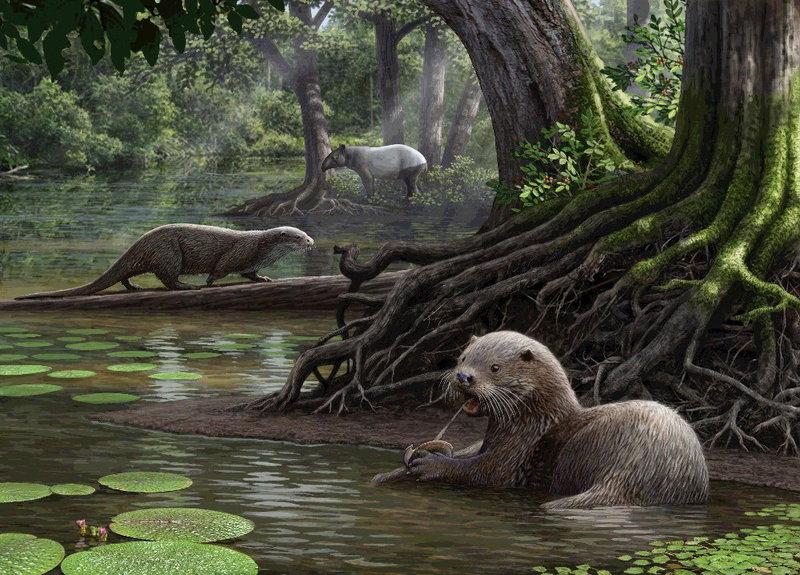Sea Otter, Giant
This is the largest of the otter family, it is native to the coasts of northern Atlantia, Lystra, and Mystra. Since the oceans rose during the Chaos Wars they can be found anywhere in Aquatica's oceans. They prefer aquatic environments but can survive on land or in the ocean, although they are happiest in the water whether it be fresh, brackish or salty.
Basic Information
Biological Traits
They are closely related to weasels, badgers, and minks, although they are not known to get along, let alone breed with their cousins. They are unique among the mustelids in rarely making dens or burrows, in not having scent glands and in being able to live their entire life without leaving the water.
The giant otter shows a variety of adaptations suitable to an amphibious lifestyle, including exceptionally dense fur, a wing-like tail, and webbed feet. The species prefers the ocean, freshwater rivers and streams, which are usually seasonally flooded, and may also take to freshwater lakes and springs. It constructs extensive campsites close to feeding areas, clearing large amounts of vegetation.
An otter's coat has pockets—pouches of loose skin under each forearm. An otter uses them to stash prey during a dive, which leaves its paws free to hunt some more.
Genetics and Reproduction
The alpha male usually has a harem of females, but a temporary pair-bonding takes place for a few days while the actual matin takes place. Giant otters mate throughout the year, but most babies are born during the dry season.
Birth occurs throughout the year, but peaks between May and June. The females are cable of delayed implantation followed by four months of pregnancy. Pregnancy can last from four to twelve months, and females give birth to between one and six babies.
Females become sexually mature between 3-4 years of age and males at around 5; however, males often do not successfully breed until a few years later.
Growth Rate & Stages
Dietary Needs and Habits
Giant otters are apex predators and a carnivore. They inhabit nearshore environments, where it dives to the seafloor to forage. It's favored prey is mostly marine invertebrates such as sea urchins, various mollusks and crustaceans, and some species of fish.
Those living in freshwater inland feed mainly on fish, including cichlids, characins (such as piranha), and catfish. The giant otter seems to be opportunistic, taking whatever species are most locally abundant. If fish are unavailable, it will also take crabs, snakes, and even small caimans and anacondas.
The species can hunt singly, in pairs, and in groups, relying on sharp eyesight to locate prey. They can often be seen hunting cooperatively and teaching their young to hunt. When the prey is too large for one otter to take alone, a hunting party is formed to complete the task. The hunt for prey can be a rapid and tumultuous process, with lunges and twists through the shallows and a few missed targets. The otter can attack from both above and below, swiveling at the last instant to clamp the prey in its jaws.
Its foraging and eating habits are noteworthy in several respects. First, its use of rocks to remove its prey from the rocks and to open shells makes it one of the few mammal species to use tools.
Additional Information
Social Structure
Although each adult and independent juvenile forages alone, sea otters commonly rest together in single-sex groups called rafts. A raft typically contains 10-100 animals, with males rafts being larger than female ones. The largest rafts can contain over 2000 sea otters. They wrap themselves in kelp to keep from being washed out to sea while resting, eating and sleeping.
Atypical of mustelids, the inland giant otters are a social species, with family groups typically supporting three to eight members and often up to 20. The groups are centered on a dominant breeding pair and are extremely cohesive and cooperative, in some groups also males have a harem of females during mating season. Although generally peaceful, the species is territorial, and aggression has been observed between groups. The giant otter is diurnal, being active exclusively during daylight hours. It is the noisiest otter species, and distinct vocalizations have been documented that indicate alarm, aggression, and reassurance.
Domestication
Uses, Products & Exploitation
Facial characteristics
Giant otter muzzles are short and sloping and give the head a ball-shaped appearance. The ears are small and rounded. The nose (or rhinarium) is completely covered in fur, with only the two slit-like nostrils visible. The giant otter's highly sensitive whiskers (vibrissae) allow the animal to track changes in water pressure and currents, which aids in detecting prey. The legs are short and stubby and end in large webbed feet tipped with sharp claws. Well suited for aquatic life, it can close its ears and nose while underwater.
Geographic Origin and Distribution
Average Intelligence
Perception and Sensory Capabilities
Remove these ads. Join the Worldbuilders Guild



Comments